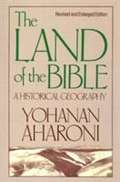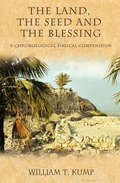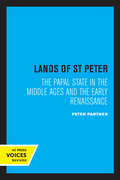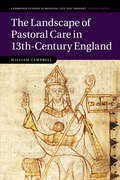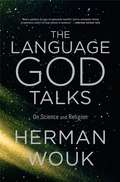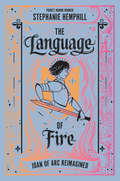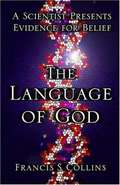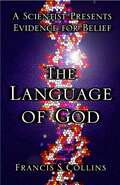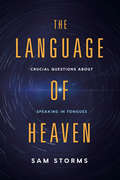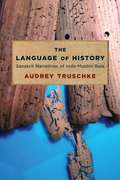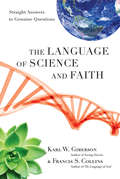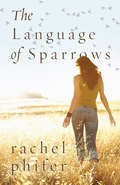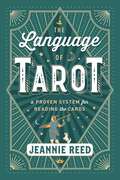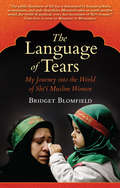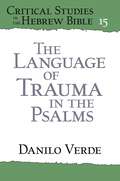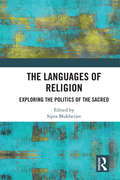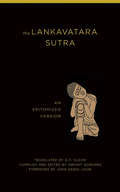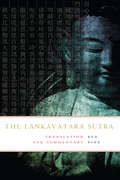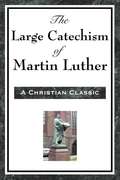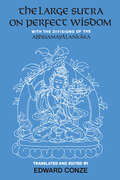- Table View
- List View
The Land of the Bible A Historical Geography: Revised and Enlarged Edition
by Yohanan Aharoni A. F. RaineySince its first publication in this country, Yohanan Aharoni's informative, fact-filled work has been a prime source in its field. Now considerably enlarged, and with both text and maps updated, this classic study offers an even more accurate description of the geography, history, and archeology of Palestine. The Land of the Bible is an essential textbook that will continue to serve both scholars and students for years to come.
The Land, the Seed and the Blessing: A Chronological Biblical Compendium
by William T. KumpA profoundly detailed and comprehensive handbook that brings order and clarity to the many stories of the Bible. The Land, the Seed and the Blessing is a unique and comprehensive handbook to the Bible that lays out the events of the Bible in chronological order and details where they occurred. Its unique organization reveals the many stories of the Bible as if it were a sprawling, page-turning historic novel. The clarity of Kump&’s Herculean efforts serves to deepen one&’s relationship to the Bible, faith, and God. The Land, the Seed and the Blessing is perfect for the average pew sitter who cannot put it all together; the young parent-inquirer who is somewhat intimidated about church and Bible; students in a college level semester Bible course; and preachers who want to do the Bible in 48 sermons of 20 to 50 minutes each.
The Lands of St Peter: The Papal State in the Middle Ages and the Early Renaissance
by Peter PartnerThis title is part of UC Press's Voices Revived program, which commemorates University of California Press’s mission to seek out and cultivate the brightest minds and give them voice, reach, and impact. Drawing on a backlist dating to 1893, Voices Revived makes high-quality, peer-reviewed scholarship accessible once again using print-on-demand technology. This title was originally published in 1972.
The Landscape of Pastoral Care in Thirteenth-Century England (Cambridge Studies in Medieval Life and Thought: Fourth Series)
by William H. CampbellThe thirteenth century was a crucial period of reform in the English church, during which the church's renewal initiatives transformed the laity. The vibrant lay religious culture of late-medieval England cannot be understood without considering the re-invigorated pastoral care that developed between 1200 and 1300. Even before Innocent III called the Fourth Lateran Council of 1215, reform-minded bishops and scholars were focusing attention on the local church, emphasising better preaching and more frequent confession. This study examines the processes by which these clerical reforms moulded the lay religiosity of the thirteenth century, integrating the different aspects of church life, so often studied separately, and combining a broad investigation of the subject with a series of comparative case studies. William Campbell also demonstrates how differences abounded from diocese to diocese, town to country and parish to parish, shaping the landscape of pastoral care as a complex mosaic of lived religion. The first complete study of the English church's activities in the 1200s for more than fifty years, providing an up-to-date and overdue re-assessment. Explains how the origins of the vibrant religious culture of late medieval England lay in the clerical reform of friars and parish priests. Demonstrates the regional and local diversity of medieval religion and how socio-economic structures affected the church's activity.
The Language God Talks: On Science and Religion
by Herman Wouk"More years ago than I care to reckon up, I met Richard Feynman." So begins THE LANGUAGE GOD TALKS, Herman Wouk's gem on navigating the divide between science and religion. In one rich, compact volume, Wouk draws on stories from his life as well as on key events from the 20th century to address the eternal questions of why we are here, what purpose faith serves, and how scientific fact fits into the picture. He relates wonderful conversations he's had with scientists such as Feynman, Murray Gell-Mann, Freeman Dyson, and Steven Weinberg, and brings to life such pivotal moments as the 1969 moon landing and the Challenger disaster. Brilliantly written, THE LANGUAGE GOD TALKS is a scintillating and lively investigation and a worthy addition to the literature.
The Language of Angels: A Story About the Reinvention of Hebrew
by Richard Michelson2018 Sydney Taylor Book Award2017 National Jewish Book AwardIn 1885, few Jews in Israel used the holy language of their ancestors, and Hebrew was in danger of being lost—until Ben Zion and his father got involved. Through the help of his father and a community of children, Ben modernized the ancient language, creating a lexicon of new, modern words to bring Hebrew back into common usage. Historically influenced dialogue, engaging characters, and colorful art offer a linguistic journey about how language develops and how one person's perseverance can make a real difference.Influenced by illuminated manuscripts, Karla Gudeon&’s illustrations bring Ben Zion—and the rebirth of Hebrew—to life.A compelling emotional journey — Publisher's WeeklyA lively introduction to the work of a Hebrew language scholar and lover—and his family — Kirkus ReviewsA perfect resource for religious school collections and public library language shelves — BooklistHebrew teachers and students in Jewish schools will welcome this gorgeous new picture book about how the language developed and the impact of one person's perseverance on an entire people — School Library Journal
The Language of Fire: Joan of Arc Reimagined
by Stephanie HemphillThe Language of Fire is a lyrical, dark, and moving look at the life of Joan of Arc, who as a teen girl in the fifteenth century commanded an army and helped crown a king of France. This extraordinary verse novel from award-winning author Stephanie Hemphill dares to imagine how an ordinary girl became a great leader, and ultimately saved a nation.Jehanne was an illiterate peasant, never quite at home among her siblings and peers. Until one day, she hears a voice call to her, telling her she is destined for important things. She begins to understand that she has been called by God, chosen for a higher purpose—to save France. Through sheer determination and incredible courage, Jehanne becomes the unlikeliest of heroes. She runs away from home, dresses in men’s clothes, and convinces an army that she will lead France to victory.As a girl in a man’s world, at a time when women truly had no power, Jehanne faced constant threats and violence from the men around her. Despite the impossible odds, Jehanne became a fearless warrior who has inspired generations.
The Language of God: A Scientist Presents Evidence for Belief
by Francis S. CollinsThe author presents a satisfying solution for the dilemma that haunts everyone who believes in God and respects science. Faith in God and faith in science can be harmonious and combined into one worldview. For Collins, science does not conflict with the Bible, science enhances it.
The Language of God: A Scientist Presents Evidence for Belief
by Francis S. CollinsDr. Francis Collins, head of the Human Genome Project, is one of the world's leading scientists -- yet he is also a man of unshakable faith in God and scripture. Dr. Collins has resolved the dilemma that haunts everyone who believes in God and respects science. Faith in God and faith in science can be harmonious -- not separately but together, combined into one worldview. For Collins, science does not conflict with the Bible, science enhances it. The Language of God makes the case for God and for science. Dr. Collins considers and dismisses several positions along the spectrum from atheism to young-earth creationism -- including agnosticism and Intelligent Design. Instead, he proposes a new synthesis, a new way to think about an active, caring God who created humankind through evolutionary processes. He explains his own journey from atheism to faith, and then takes listeners on a stunning tour of modern science to show that physics, chemistry, and biology can all fit together with belief in God and the Bible. The Language of God is essential for anyone who wonders about the deepest questions of all: Why are we here? How did we get here? And what does life mean?
The Language of Heaven: Crucial Questions About Speaking in Tongues
by Sam StormsWhat does the gift giver say about the gift He gave? This book will help you overcome the arguments, fears, and anxieties related to this gift. FEATURES AND BENEFITSShares the author&’s personal testimony and spiritual journey with speaking in tonguesExamines the history of this gift in the church for the past two thousand yearsInteracts with those who have denied that this gift is valid for today&’s churchSpeaks to the relationship between Spirit baptism, Spirit filling, and the gift of tonguesFew other issues have separated the church more than the issue of tongues. Sam Storms focuses on this controversial subject with his signature insights to theology and the gifts of the spirit. What does the gift giver say about the gift He gave? Storms seeks to bring balance to this subject in The Language of Heaven as he wrestles with this sensitive issue experientially as well as theologically. He ultimately provides a platform to allow God to speak for Himself as he addresses every text of Scripture on the subject and engages with every theological issue that speaking in tongues provokes. As a pastor, Storms knows the questions that the typical churchgoer is asking and provides clear and accessible answers to them all, including:Is the gift of tongues for every Christian or only some?How does the gift of tongues operate in the life of the believer individually in private practice?How does the gift of tongues operate in the corporate assembly of God&’s church?How is the Christian edified and strengthened by praying in tongues?How do I pray for the gift and prepare my heart to receive it?You can overcome the arguments, fears, and anxieties related to this spiritual gift. Remember, God gives only good gifts, and it is His intention that His church utilize all that He has provided so that we might experience all that He is.
The Language of History: Sanskrit Narratives of Indo-Muslim Rule
by Audrey TruschkeFor over five hundred years, Muslim dynasties ruled parts of northern and central India, starting with the Ghurids in the 1190s through the fracturing of the Mughal Empire in the early eighteenth century. Scholars have long drawn upon works written in Persian and Arabic about this epoch, yet they have neglected the many histories that India’s learned elite wrote about Indo-Muslim rule in Sanskrit. These works span the Delhi Sultanate and Mughal Empire and discuss Muslim-led kingdoms in the Deccan and even as far south as Tamil Nadu. They constitute a major archive for understanding significant cultural and political changes that shaped early modern India and the views of those who lived through this crucial period.Audrey Truschke offers a groundbreaking analysis of these Sanskrit texts that sheds light on both historical Muslim political leaders on the subcontinent and how premodern Sanskrit intellectuals perceived the “Muslim Other.” She analyzes and theorizes how Sanskrit historians used the tools of their literary tradition to document Muslim governance and, later, as Muslims became an integral part of Indian cultural and political worlds, Indo-Muslim rule. Truschke demonstrates how this new archive lends insight into formulations and expressions of premodern political, social, cultural, and religious identities. By elaborating the languages and identities at play in premodern Sanskrit historical works, this book expands our historical and conceptual resources for understanding premodern South Asia, Indian intellectual history, and the impact of Muslim peoples on non-Muslim societies.At a time when exclusionary Hindu nationalism, which often grounds its claims on fabricated visions of India’s premodernity, dominates the Indian public sphere, The Language of History shows the complexity and diversity of the subcontinent’s past.
The Language of Science and Faith: Straight Answers to Genuine Questions
by Francis S. Collins Karl W. GibersonThe Language of God,
The Language of Sparrows
by Rachel PhiferBrilliant and fluent in too many languages to count, 15-year-old Sierra Wright can't seem to communicate what is important to her in any language. Though April Wright stubbornly keeps an upbeat attitude about her daughter's future, she has let her own dreams slip away. Just across the bridge lives old Luca, scarred from his time in a Romanian gulag years before. Though he has seemingly given up on people, Sierra is drawn to him despite his prickly edges.No one else is comfortable with the unpredictable old man spending time alone with Sierra, not even Luca's son. Yet it is this unconventional relationship that will bring two families together to form friendships and unearth their family stories, stories that just might give them all the courage to soar on wings toward a new future. ---"With The Language of Sparrows, Rachel Phifer creates an engaging, tender tale of the hope that can arise when painful secrets are brought into the light. Poignant backstory and multifaceted characters draw the reader in and keep the pages turning." Amy K. Sorrells, award-winning author of How Sweet the Sound"The Language of Sparrows, by Rachel Phifer, is a beautifully written story of betrayal and an unlikely friendship, forged from understanding. Novel Rocket and I recommend it. It's a perfect book club selection or an end-of-summer read." Ane Mulligan, president of Novel Rocket
The Language of Sycamores
by Lisa WingateFrom the book jacket: karen Sommerfield has been hiding from the big questions of life- immersing herself in a high-pressure job, ignoring the emotional distance in .her marriage, avoiding memories of a sudden miscarriage and a bout with cancer that stole her chance of ever having children. She's convinced herself that money, power, and success can give her the sense of purpose she yearns for...until the day the company downsizes her out of a job and the doctor tells her that the cancer may be back. It's a double blow that would send anyone reeling. It sends Karen on a search for herself in the last place she ever thought to look: Grandma Rose's old farm, where her sister has made a seemingly perfect life. As Karen's hectic schedule falls away, she opens up to the unexpected-a lonely child in need of nurturing and newly discovered family members with insights into the past. In the quiet of the Missouri Ozarks, she once again hears the call of the river and the whispers of the sycamore leaves. In their soft, secret language, she will discover answers, a forgotten purpose, and a joy to make her life complete.
The Language of Tarot: A Proven System for Reading the Cards
by Jeannie ReedReading the cards can be as easy as reading this sentence.Welcome to a world of tarot you couldn't have imagined until now—a world in which you can give accurate and insightful tarot readings with little or no guesswork while also developing your psychic ability. This revolutionary guide, written by a tarot master with more than thirty years of experience, teaches a simple, proven system that makes reading cards in a spread as straightforward as reading words on a page.The Language of Tarot presents an innovative system that treats tarot as a science. It can be taught and learned. Jeannie Reed discovered that when the same two or three cards appear together, it usually represents the same issue in any client's life. This remarkable book translates many card combinations and supplies examples to support each lesson. You can be more creative and confident with card meanings as you uncover how they relate to matters of health, money, relationships, and more. With Jeannie's guidance, it's easy to become fluent in the language of tarot.
The Language of Tears
by Bridget BlomfieldThe Language of Tears details the engaging five-year experience of a gifted American scholar throughout her journey teaching and participating in a Shi'a Muslim community in Southern California. As a teacher in a Muslim school, she participates in the lives of Iranian, Iraqi, and Pakistani women as they perform their religious rituals. Initially thought to be an FBI informant, Blomfield builds trust as she participates in every aspect of their lives.Only a few weeks after she starts teaching, the fifth-grade girls invite her to attend a religious ritual after school. Sitting, covered in black, she starts to engage: hearing the laments of the women, she too starts to weep. She is invited into the women's homes, where they share their hopes, dreams, and fears. She dances at weddings, baby showers, and a Mother's Day "women's only" swim party. She is deeply honored when she is invited to ritually wash and bury an old Iranian woman's body, erupting a love for her own mother and her imminent death. Finally, she travels to Iran for a surreal religious pilgrimage where she becomes Shi'a "in her heart," becoming more fully human.
The Language of Trauma in the Psalms (Critical Studies in the Hebrew Bible)
by Danilo VerdeOver the last few decades, the field of trauma studies has shed new light on biblical texts that deal with individual and collective catastrophe. In The Language of Trauma in the Psalms, Danilo Verde advances the conversation, moving beyond the emphasis on healing that prevails in most literary trauma studies. Using the lens of cognitive linguistics and combining insights from trauma studies and redaction criticism, Verde explores how trauma is expressed linguistically in the book of Psalms, how trauma-related language was rooted in ancient Israel’s external realities, and how psalms helped define Yehud’s cultural trauma in the Persian period (539–331 BCE). Rather than assuming the psalmists’ personal experiences are reflected in these texts, Verde focuses on the linguistic strategies used to express trauma in the Psalms, especially references to the body and highly dramatic metaphors. Current analyses often approach trauma texts as tools intended to help sufferers heal. Verde contends that many group laments in the book of Psalms were transmitted not only to heal but also to wound the community, ensuring that the pain of a previous generation was not forgotten.The Language of Trauma in the Psalms shifts our understanding of trauma in biblical texts and will appeal to literary trauma scholars as well as those interested in ancient Israel.
The Language of the Soul in Narrative Therapy: Spirituality in Clinical Theory and Practice
by Laura BéresThe Language of the Soul in Narrative Therapy uniquely bridges the gap between narrative therapy and spirituality to describe how the theory and practice of narrative therapy may be expanded and enriched by incorporating the language of the soul. Divided into three parts, the book begins by contextualizing the approach of narrative therapy and spirituality. Chapters then debate the complexity of the ‘soul’ as a term drawing on the work of Christian mystics and philosophers, such as Teresa of Avila, Edith Stein, Merleau-Ponty, and Bakhtin, to show how their theoretical ideas can be incorporated in counseling practice and spiritual direction. The book concludes by discussing how the language of the soul can be integrated and applied in postmodern practice. With case examples from faith belief systems, such as Christianity, Buddhism, Paganism, Wicca, and Yazidism, throughout, this book is essential reading for therapists, clinical social workers, and counsellors in practice and graduate training, as well as spiritual directors and pastoral counselors interested in the ideas and practices of narrative therapy.
The Languages of Magic: Transform Reality through Words, Magical Symbols, and Sigils
by Toby Chappell• Introduces key ideas in linguistics and semiotics to reveal how magic works• Reveals how to apply effective communication techniques to your magical practice• Includes case studies of magical schools, such as Hermetic magic, sigil magic, Thelema, the Church of Satan, Chaos Magic, and the Temple of SetIn this illuminating and deeply informative guide, practicing magician Toby Chappell takes readers on a journey into the heart of what it means to transform reality by exploring what magic is. He explains that operative magic works because it is communication. The practitioner of magic is communicating with the unmanifest to align the outside world with their inner transformations, desires, and needs.Drawing on linguistics and the analytical techniques of semiotics, the author explores how we perceive and affect the world by treating it like a partner in communication. He shows how this notion of magical communication appears in ancient practice, looking specifically at Hermetic magic and the spells of Greek magical papyri, sigil magic, Enochian magic, and runes. He explains the symbol-building necessary to effectively transform your inner and outer reality with magical speech, signs, and sigils. The author examines the languages of magic in contemporary New Thought practices, and he also looks at magical communication in several modern and postmodern schools of magic, including Thelema and the teachings of Aleister Crowley, Thee Temple ov Psychick Youth, the Church of Satan, Chaos Magic, and the Temple of Set.Revealing how to apply techniques of effective communication to the magical realm, the author shows how you can deepen your understanding of magical practice and, ultimately, perform magic with greater success.
The Languages of Religion: Exploring the Politics of the Sacred
by Sipra MukherjeeThis book analyses the power that religion wields upon the minds of individuals and communities and explores the predominance of language in the actual practice of religion. Through an investigation of the diverse forms of religious language available — oral traditions, sacred texts, evangelical prose, and national rhetoric used by ‘faith-insiders’ such as missionaries, priests, or religious leaders who play the communicator’s role between the sacred and the secular — the chapters in the volume reveal the dependence of religion upon language, demonstrating how religion draws strength from a past that is embedded in narratives, infusing the ‘sacred’ language with political power. The book combines broad theoretical and normative reflections in contexts of original, detailed and closely examined empirical case studies. Drawing upon resources across disciplines, the book will be of interest to scholars of religion and religious studies, linguistics, politics, cultural studies, history, sociology, and social anthropology.
The Lankavatara Sutra
by D. T. Suzuki Dwight GoddardSaid to contain the words of the Buddha on the nature of ultimate wisdom, the Lankavatara was influential in the general doctrines of Mahayana Buddhism, in particular Zen. Translated by D.T Suzuki and edited by Dwight Goddard, this epitomized version was intended to make the sutra more widely accessible.
The Lankavatara Sutra: Translation and Commentary
by Red PineHaving translated The Diamond Sutra and The Heart Sutra, and following with The Platform Sutra, Red Pine now turns his attention to perhaps the greatest Sutra of all. The Lankavatara Sutra is the holy grail of Zen. Zen's First Patriarch, Bodhidharma, gave a copy of this text to his successor, Hui-k'o, and told him everything he needed to know was in this book. Passed down from teacher to student ever since, this is the only Zen sutra ever spoken by the Buddha. Although it covers all the major teachings of Mahayana Buddhism, it contains but two teachings: that everything we perceive as being real is nothing but the perceptions of our own mind and that the knowledge of this is something that must be realized and experienced for oneself and cannot be expressed in words. In the words of Chinese Zen masters, these two teachings became known as "have a cup of tea" and "taste the tea." This is the first translation into English of the original text used by Bodhidharma, which was the Chinese translation made by Gunabhadra in 443 and upon which all Chinese Zen masters have relied ever since.In addition to presenting one of the most difficult of all Buddhist texts in clear English, Red Pine has also added summaries, explanations and notes, including relevant Sanskrit terms on the basis of which the Chinese translation was made. This promises to become an essential text for anyone seeking to deepen their understanding or knowledge of Zen.
The Large Cathechism of Martin Luther
by Martin LutherBy 1529, the year of publication of Luther's Large Catechism, parishioners took the Gospel for granted. Many had forgotten at what great peril the freedom of their faith had been won. In the Large Catechism Luther set out to inculcate the centrality of the Gospel that was largely neglected and whose freedom was frequently abused. Whether Luther is therefore dealing with the Ten Commandments or the Lord's Supper, the dynamic of the Word of God as Gospel provides the cutting edge for what he says. To obscure the Gospel is to lose everything; to illuminate it is to gain all its promises. But it is not a Gospel with a purely individualistic thrust. To risk all for the Gospel is to relate one's self to society and the Christian community. And it is this corporate dimension of the Gospel, involving him who believes all to serve all, which gives Luther's exposition of the basic ingredients of the Christian faith such significance and relevance. Therefore the Large Catechism is a primary source for an understanding of the Christian ethos in action in Reformation Christianity. The Gospel is particularized. The social situation comes alive in concrete terms in a language whose meaning is unmistakable and clear.
The Large Sutra on Perfect Wisdom: With the Divisions of the Abhisamayalankara (Center for South and Southeast Asia Studies, UC Berkeley #18)
by Edward ConzeSome 2000 years ago Buddhism experienced a major reformation through a movement called the Mahayana, or "Great Vehicle," which dominated religious through in much of Asia for many centuries and still exerts considerable influence. The basic Mahayana texts, sermons ascribed to the Buddha and called "sutras" in Sanskrit, discussed the "perfect wisdom." The "Large Sutra on Perfect Wisdom" took shape between 50 and 2000 A.D. in southern India during one of the most momentous outbursts of religious creativity in human history.
